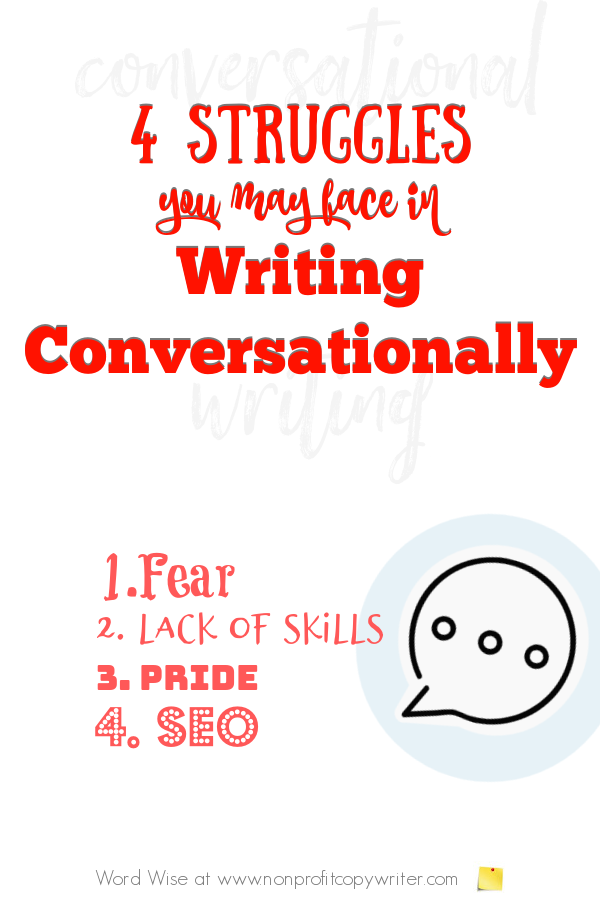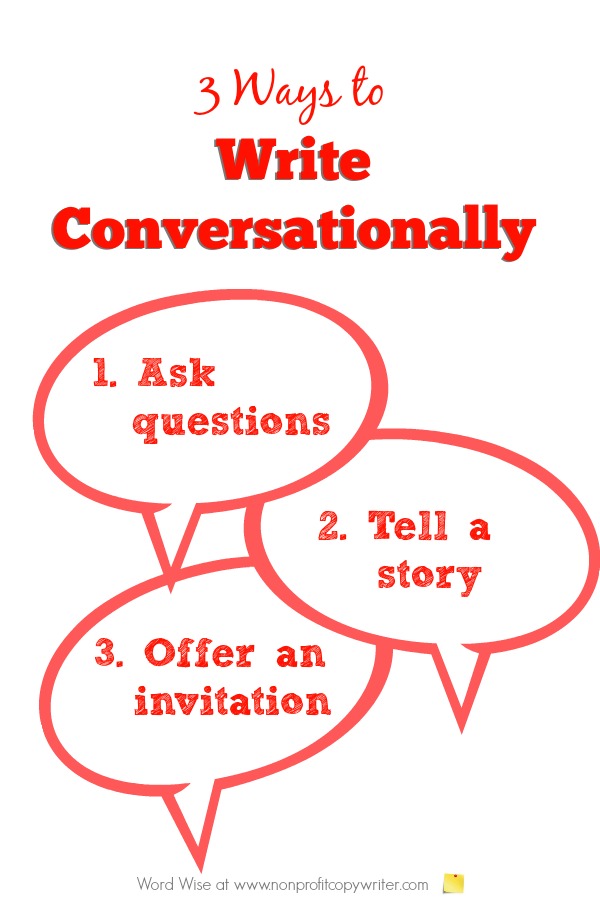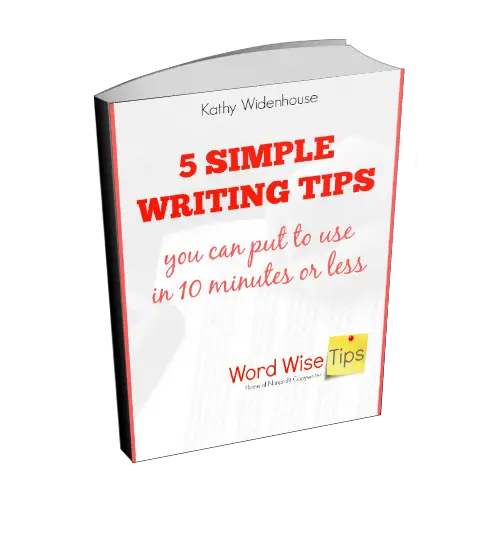Save Time: Get 5 Simple Writing Tips
you can put to use in 10 minutes
Beat the Struggle to Write Conversationally With 3 Starter
Tips
Award-winning writer Kathy Widenhouse has helped hundreds of nonprofits and writers produce successful content , with 750K+ views for her writing tutorials. She is the author of 9 books. See more of Kathy’s content here.
Updated 10.10.24
“My wife doesn’t understand what I write,” a ministry leader recently confessed to me. “And if I can’t get through to her – someone who appreciates my thoughts – then how will others read my work and listen to what I say? I know I need to change how I write.”
I took a peek at this precious man’s content. Sure enough, it had depth. But I had to read each sentence two or three times to make sense of it.
He wrote formally, rather than conversationally.
You’ve heard it over and over from content writing gurus: "Write like you talk."
Yet maybe you’re among the more than one in three content writers, like my friend, who struggle to write conversationally. And that impacts your ability to connect with your readers.
Readers expect a conversational style when they read an email, web page, text, blog, social media post – anything online. They’re used to commenting on blogs and interacting with pop ups and apps. Conversational writing is also the norm when readers see ads, direct mail, and consumer newsletters.
You’ll be most successful at web writing and content writing when you foster two-way interaction with your reader – that is, when you write conversationally. You want to write in such a way that she has a discussion with you, whether it’s in her head or on the screen.
To get started, take a look at why you may push back from writing like you talk.
Why you may struggle to write conversationally
1. Fear
Conversational writing bends the rules. Breaking the rules makes us uncomfortable – especially you come from an academic or corporate background. Or if you’re a rule follower, like me.
The mere thought of starting a sentence with a conjunction or including a sentence fragment in your blog post has you shaking at your keyboard. You’re afraid a casual tone undermines your authority or credibility.
Worse, you quake at the idea of being labeled “unprofessional” … especially if you’re trying to break into freelance writing or build a blog or sell your skills as a content writer.
But there’s a problem with formality. It creates distance. If you want to be taken seriously – even viewed as an expert – you need to offer quality content that readers can easily understand. That means a casual tone.
2. Lack of skills
Mrs. Rodgers drilled proper grammatical construction into the core of your being during eighth grade language arts class. You have been conditioned to write formally in school and work, where academic essays, reports, and business writing dominate.
Beyond that, you haven’t been coached in the basics of informal writing: short words. Short sentences. Lots of white space. Frequent use of first- and second-person over third person. Plenty of linking words.
In conversation, people are spontaneous, but when writing, you can get stuck trying to organize your thoughts too perfectly. You over polish the content and lose the natural flow of conversation.
Such was the situation for my pastor friend. He was “too educated” to write simply. Fortunately, he had good ears – ones that listened to the rhythms of how others talk – and step by step, he incorporated those patterns into his writing.
Conversational writing skills are learnable.
3. Pride
Yep, you want to impress your readers.
You feel like a pro when you produce complicated sentences splattered with linguistic gymnastics. All that high falutin’ language is above your Average Joe.
But in truth, complex content has the opposite effect. It’s stiff and unnatural, which inhibits conversation. (You’ve tried to carry on a dialogue with the super-intellectual neighbor at your neighborhood block party, haven’t you?)
While six syllable words may get you a higher score on your college entrance exam, they won’t build a connection with your reader. A real writing pro makes difficult ideas understandable.
4. SEO
When you write online – eager for more visitors to land on your site for free – then you optimize your pages in a way that appeals to search engines. You use SEO (Search Engine Optimization). It’s the process of creating a page for the web to return strong search results.
Among many SEO best practices are …
- Focusing your content on one or two keywords (terms or phrases associated with a particular topic)
- Placing keyword phrases in six crucial places on the page
- Ensuring high keyword density so your page is noticed by the search engines – while avoiding keyword stuffing
Writers work hard to meet those needs. But when you work too hard, you end up with unnatural content that tries to please Google and Bing. Human readability plummets.
Don’t fall into this trap.
While search engines scan pages for keywords and where they’re placed, that’s not the only factor that plays into search engine results.
One of the deepest-kept online writing success secrets is this: search engines place a high value on conversational writing. Well-constructed, optimized – and readable – content wins out over overly-keyword conscious content.
How you can write conversationally: 3 starter tips
There are dozens of tips you can use to write like you talk. And I’d rather not overwhelm you.
You can make the leap from formality to informality with just a bit of practical help.
So I harken back to my conversation with my pastor friend. I gave him 3 of my favorite conversational writing tips.
Anyone can manage three changes. Get started with these. And you can add more later.
1. Write conversationally when you ask questions
How do you respond when you read a question? (Made you think, didn’t I?)
You mentally respond. Perhaps you may even type a quick answer if you’re online, on a blog, on a social media site, or reading an email. Asking questions sparks conversation in person.
It does the same thing in writing, too. It’s an easy technique. Skim this page and see how many times I ask questions. See what I mean?
2. Write conversationally by telling a story
A friend began journaling at the encouragement of her accountability partners. Two weeks later she reported back. “This journaling thing helped me see a negative attitude I had towards a co-worker. I never realized that writing down my thoughts can help so much.”
That’s a story. (It’s true, by the way.)
Pulled you in, didn’t it? You may identify with my friend and you may want to know more. You may want to know what was going on at my friend’s work. You may want to know what she’s journaling about now. You may want to comment about how journaling was a turning point for you, too.
The story is a hook that engages you. Engagement = conversation.
It doesn’t have to be a big story with multiple characters and several plot lines. In fact, short anecdotes work best to engage readers.
3. Write conversationally by giving an invitation
Invite your reader to try something. For instance …
- Want to learn more about conversational copywriting? I wrote a page that explains the differences between traditional copywriting (writing to sell) and conversational copywriting (writing to build a relationship.)
- Or if you’re into figuring out the mechanics of online conversational writing, check out this post with some practical tips.
- You may want to check out Conversational Copywriting, a low-cost online course by online copywriting whiz Nick Usborne. This online copywriting resource shows you how to write your copy in a natural, authentic and conversational voice.
Do you see what just happened? I invited you to learn more. I told you where and what and who and how. When you offer your reader an invitation, you’re taking the first step in building a relationship.
Which is the whole idea behind writing conversationally. Isn’t it?
More Tips for Web Writing
Why You MUST Master a Conversational Writing Style ...
19 Practical Conversational Writing Tips ...
Use 3 Types of Web Traffic to Build Your Blog or Website ...
Run-On Sentences Can Be Your Friend. Fragments, Too...
Contextual Links and Why You Need Them on Your Website ...
What Is SEO Content Writing? Tips for Strong Search Results ...
The Top Online Copywriting Tip ...
Web Writing versus Writing for Print: how they are different ...
Online Writing: How It Is Unique ...
How Keywords Work: an overview ...
Keyword Glossary: Quick SEO Jargon at Your Fingertips ...
6 places to use keywords in web pages and blog posts ...
Long Tail Keywords: A Quick Guide to Using Unpopular Search Terms ...
Review: Conversational Copywriting - an Online Writing Course ...
The Best Word Count for SEO ...
5 Web Content Copywriting Tips ...
3 Simple Tips for Writing Better Web Pages ...
Top Ten Website Writing Tips ...
More Online Copywriting Tips on our Pinterest board ...
Return from 3 Practical Ways to Write Conversationally to Nonprofit Copywriter home
As an Amazon Associate I earn from qualifying purchases.
Share This Page

Named to 2022 Writer's Digest list
BEST GENRE/NICHE WRITING WEBSITE


Stop Wasting Time!
Grab your exclusive FREE guide, "5 Simple Writing Tips You Can Put to Use in 10 Minutes or Less"













